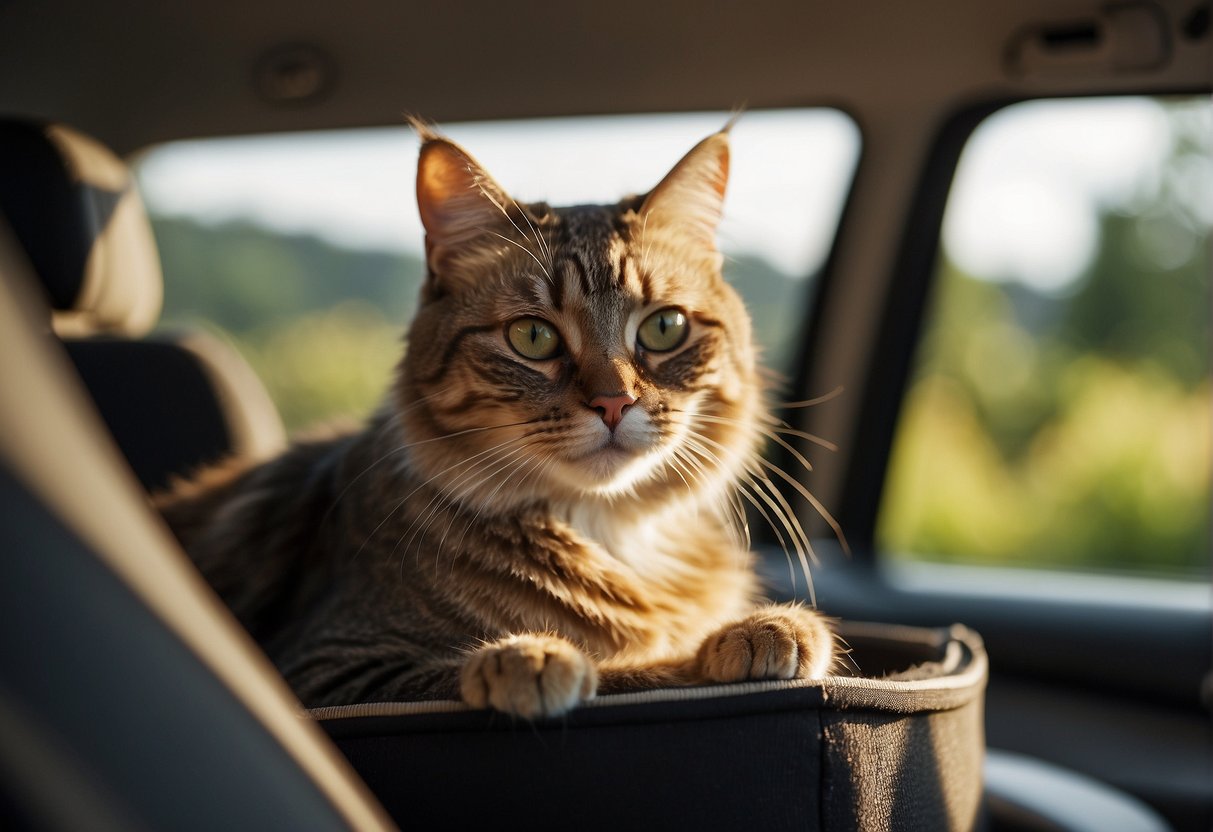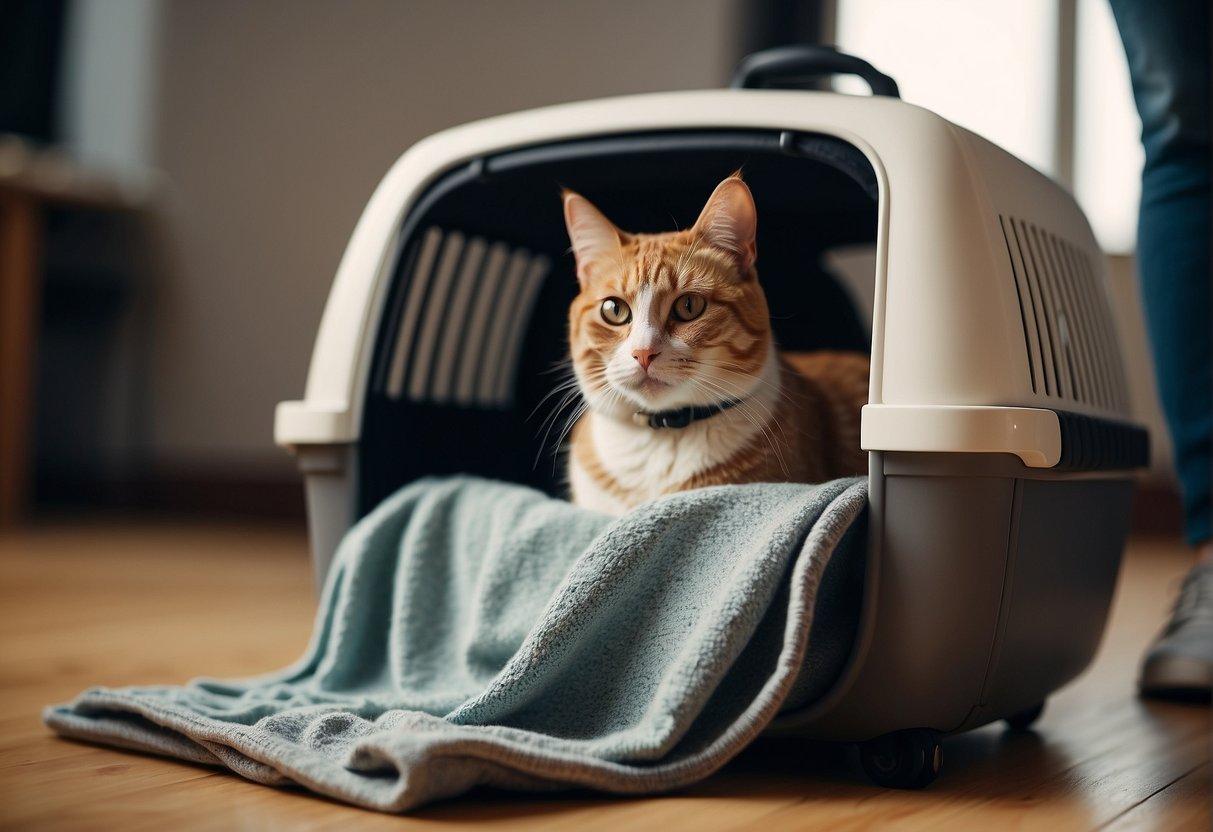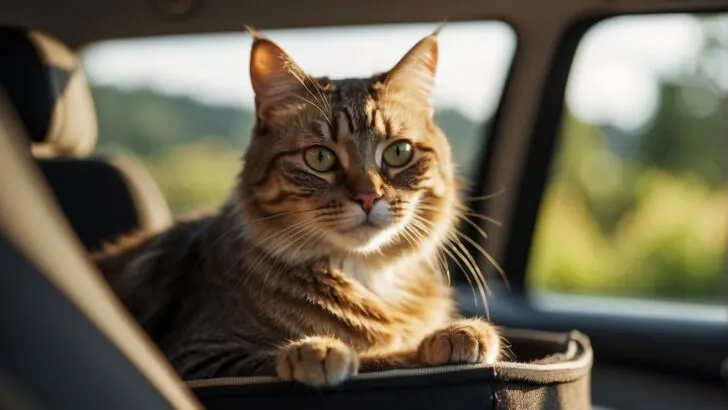Traveling with your cat by car can be a smooth experience with the right preparation. Cats are creatures of habit and may not embrace the idea of a road trip as readily as some of our canine friends, but with patience and careful planning, you can help your feline companion become more comfortable with car rides.
It’s essential to invest in a sturdy, secure cat carrier, as it not only ensures your cat’s safety but also helps reduce their stress levels. Padding the carrier with familiar blankets or toys can make it a more inviting space for your cat.

Addressing your cat’s needs while on the road is crucial. Ensuring they have access to comfortable resting areas, regular meals, and plenty of water helps maintain their well-being during travel.
Try to create a calm environment in the car by keeping the noise levels down and the temperature regulated. Cats typically prefer a cooler setup, so adjust the air conditioning if needed. Remember, car rides for cats aren’t just about the destination. It’s about ensuring the journey is as stress-free as possible.
With each successful short trip, you’re paving the way for longer adventures together. Keeping the carrier within your cat’s daily environment as a resting place can further associate it with positive experiences, making the transition to the car smoother.
Preparing Your Cat for Car Travel

Traveling by car with your cat can be a comfortable experience for both you and your feline friend with proper preparation. Ensuring that your cat is well-adjusted to their carrier and the car environment reduces stress and promotes safety.
Choosing the Right Carrier
Your cat’s carrier is their safe space during travel. Choose a hard-sided carrier for durability or a soft-sided carrier for a bit more flexibility in fitting into car spaces. Check that the carrier is large enough for your cat to stand, turn around, and lie down. Secure the carrier with a seatbelt to prevent movement during the drive.
Training and Desensitization
Training your cat to be comfortable with their carrier can take time, but it’s essential for a stress-free journey. Begin by setting the carrier in your home with the door open, allowing your cat to explore it at their own pace.
Use positive reinforcement like treats or their favorite toys to encourage them to enter the carrier. Gradually progress to doing short, non-stressful practice runs in the car to build their tolerance.
Health and Safety Precautions
Before embarking on your journey, visit your vet to ensure your cat is in good health and up-to-date on vaccinations. It’s also wise to prepare a pet first-aid kit with essentials like bandages and antiseptics.
Keep your vet’s contact information and your cat’s medical records handy. If your cat is prone to anxiety, discuss options with your vet. Lastly, consider a snug-fitting cat harness for added security during breaks from the carrier.
During the Car Ride
Embarking on a road trip with your feline friend can be an enjoyable adventure if you plan for comfort, hydration, and stress management. The movement of the car and new environments can be overwhelming for cats, but with the right preparations, you and your cat can have a pleasant journey.
Managing Stress and Anxiety
Your cat’s well-being is paramount during travel. Stress and anxiety can be mitigated with a few strategies:
- Use calming pheromones which help soothe feline nerves.
- Bring familiar toys or a piece of home bedding to reassure them.
- Medication: Consult your vet about motion sickness or anti-anxiety medication if your cat is prone to severe stress.
- Recognize signs of discomfort, such as panting or vocalizing, and address them calmly.
Entertainment and Comfort
Keeping your cat entertained and comfortable is crucial:
- Schedule play sessions to keep them engaged.
- Catnip and favorite toys can make the carrier more appealing.
- Create a cozy space for a nap with soft blankets or their usual bed.
- Climate control is important. Keep the car cool and well-ventilated.
Feeding and Hydration
Nutrition and hydration are not to be overlooked on the road:
- Meals: Stick to your cat’s feeding routine with their regular cat food; sudden changes can cause upset stomachs.
- Treats: Offer cat treats sparingly as rewards and to encourage positive associations with travel.
- Fresh water should always be accessible. Use a stable water bowl to prevent spills.
- Litter box: Have a travel litter solution. Portable litter boxes are a good option. Be sure to stop regularly to give your cat a chance to use it.
Planning Your Road Trip
Embarking on a car travel adventure with your feline friend involves more than packing a bag and hitting the road. It requires thoughtful preparation to ensure both your and your cat’s well-being, especially for cross-country or long-distance excursions.
Creating a Cat-Friendly Itinerary
Your cat thrives on routine and familiar scents, making territory paramount. To make your road trip cat-friendly:
- Map Out Regular Pit Stops: Plan for breaks every 2-3 hours to offer your cat exercise and playtime. This helps to mitigate stress and keep them calm.
- Research Pet-Friendly Hotels: Search ahead for places to stay that welcome pets. Double-check their policies to ensure your cat’s needs can be accommodated.
- Comfort is Key: Place a blanket or bed with home scents in their carrier to reinforce a sense of security in the moving vehicle.
Handling Emergencies
A successful road trip with your cat means being prepared for any mishaps:
- Pack a Pet First-Aid Kit: Include items like gauze, tape, scissors, and antiseptic for unexpected injuries.
- Carry Vet Records: Always travel with your cat’s health records for emergencies and if required by pet-friendly hotels.
- Identification: Ensure your cat has a collar with ID tags and consider a microchip for added security.
Arrival and Acclimation
When you arrive at your destination with your feline friend, it’s essential to make the transition as smooth as possible. Cats are territorial and rely heavily on scent to feel secure, so introducing them to a new environment can be stressful.
Making Your Cat Feel at Home:
- Allow your cat to explore their new surroundings inside the carrier first, maintaining a familiar scent and sense of security.
- Set up a safe space with their favorite blanket or toys to provide comfort and familiarity.
- Keep the room quiet; sudden noises can startle them.
Positive Reinforcement:
- Offer treats when your cat shows curiosity or calmness.
- Engage in play with a favorite toy to create positive associations with the new space.
If staying in hotels:
- Check ahead to ensure the hotel is cat-friendly.
- Use a removable door sign to inform staff there’s a cat inside, to avoid surprises.
Familiarizing with Territory:
- Once settled, you can rub a soft cloth on your cat’s face to pick up their scent, then dab it around the room at cat height for a sense of territory.
- Gradually introduce them to other areas, supervised to prevent hiding in inaccessible spots.
Remember, kittens and adult cats alike will need time to acclimate. Patience is key. Turn off the car’s engine and ensure the room is comfortable—not too hot or cold. Reinforce that their carrier is a safe space, even while stationary, and keep it accessible.

My name is James, and welcome to FAQCats!
Along with our team of cat owners, expert pet enthusiasts, and pet professionals, we aim to write engaging helpful, engaging content about cats. At FAQCats we strive to provide content that’s accurate and fun to read. Our team writes about everything related to cats; even the most complex of topics. Through extensive research and caring for our own fur-pals, we’re able to provide something cat owners worldwide will love. Have a look around, and leave us feedback anytime!

